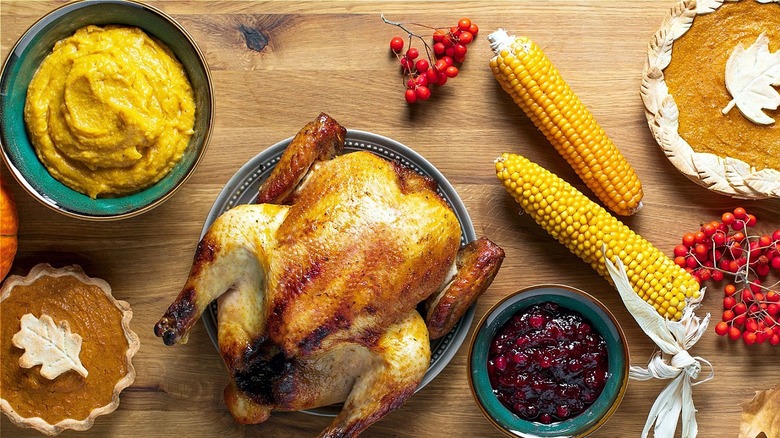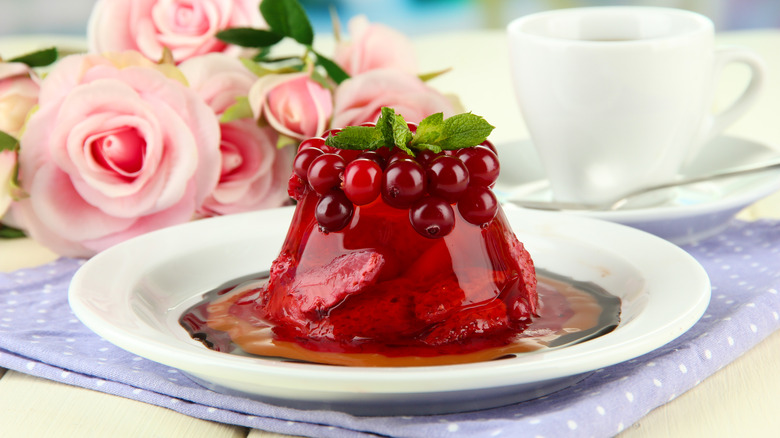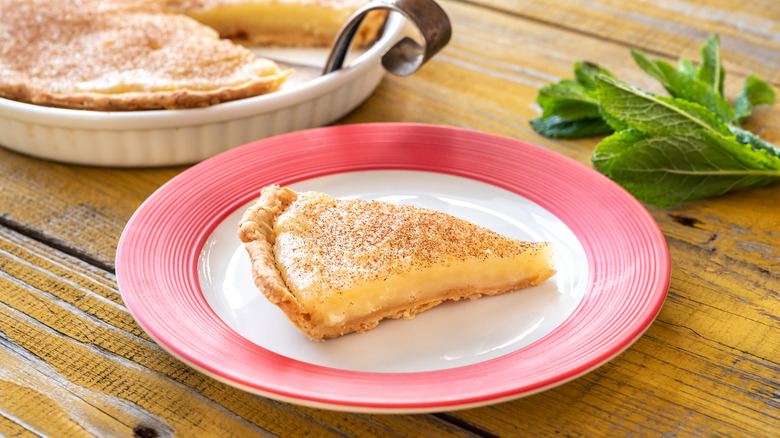What Thanksgiving Dinner Looked Like During The Great Depression
As the mournful notes of "Brother, Can You Spare A Dime?" played over the radio on Thanksgiving Day 1933, the dark days of the Great Depression hung over the country. With unemployment at record highs, and before the days of social assistance and food stamps, people were struggling to put any food on the table, let alone a feast worth of a Thanksgiving celebration. However, enterprising citizens found ways to stretch that dime to celebrate our most American of holidays.
Many items were out of financial reach for the average American during the Great Depression. According to The Morris County Library, in 1933, turkey cost $0.23 per pound. While that's literally pennies now, JSTOR reports that, at the end of 1933, wages were only $0.52-$0.53 per hour, meaning that a meager 13.2-pound turkey (which Insider notes was the average turkey size in 1929) would clock in at $3.04. The Beaumont Enterprise reports that a dinner for six would cost $5.50 on average, or more than 10 hours worth of wages for those who were lucky enough to be working.
With turkey being so expensive, creative chefs found ingenious workarounds during this time. One option was to use "old roasted hens" instead (via Cheapism). Older chickens past their laying prime or roosters, as The Prairie Homestead notes, just need to be cooked low and slow in moisture to break down the potentially tough bird. Another option was to create mock duck by rolling inexpensive flank steak with stuffing, then searing it and roasting it to mimic pricey duck.
Cheaper alternatives made a Thanksgiving feast possible
During this time in American history, people also found ways to stretch what meat they did have even further. Food52 writes that one family's Depression-era Thanksgiving recipe was for porcupine meatballs. No, not made with porcupine meat, but stuffed with inexpensive rice (five pounds only cost $0.15 in 1933, says the Indiana Times) that gave it its "prickly" texture. The rice bulked up the meat and made it more filling.
Some staples, however, were more reasonable. "Irish" potatoes were only $0.05 for 2 pounds (via The Beaumont Enterprise). And The New York Times reports that the government created a fictional radio persona — "Aunt Sammy" — from the Bureau of Home Economics to give tips to families looking to stretch their meals. Aunt Sammy had many suggestions, such as eliminating what had then been a traditional Thanksgiving oyster stew and instead serving sides like creamed pearl onions and candied sweet potatoes. The advent of canned vegetables like peas, green beans, and asparagus also provided a cheap, nutritious option for penny-pinching home chefs. With root vegetables storing well through the winter after a good summer harvest, Cheapism notes that potato pancakes became a Thanksgiving staple as well.
Gelatins also grew in popularly, The New York Times reports. A favorite of Victorians, Historic Food notes, were savory items encased in aspic, a gelatin made primarily of meat stock, and set in molds. With the birth of instant gelatins, "molded salads" with fruits and nuts became part of the Thanksgiving tradition, often served with a flavored mayonnaise dressing.
People also used what was locally available for the meal
Resourceful Americans would also look to foraging in order to source what food they could for their Thanksgiving meal during the Great Depression. Apples, raisins, chestnuts, cranberries, even dandelion greens became part of the menu — particularly the greens, which were readily available almost everywhere (via Cheapism). Chestnut stuffing became a favorite, reports The Beamont Enterprise, as well as items like Asparagus Swiss (a creamy concoction of asparagus, onions, and celery, topped with breadcrumbs).
And, at the end of the meal, pumpkin pie was still the go-to dessert, but with two cans of puree costing $0.25 — about half of an hourly wage — it could be pricey (via The Morris County Library). So, most resorted to using fresh pumpkins where they could. But, as The New York Times notes, the advent of canned pumpkin meant there were fewer whole pumpkins available as many were being purchased for the canning market. So a new favorite emerged: an Indiana Sugar Cream pie. According to Cheapism, it was often referred to as a "Hoosier cream pie," and was made with simple ingredients like a crust, sugar, cornstarch, milk, and butter (via Taste of Home).


